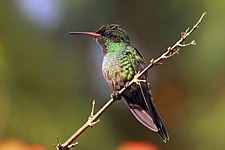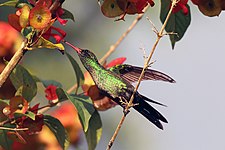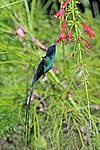Red-billed streamertail
| Red-billed streamertail | |
|---|---|

| |
| Adult male, Jamaica | |

| |
| Female, Jamaica | |
| Scientific classification | |
| Kingdom: | Animalia |
| Phylum: | Chordata |
| Class: | Aves |
| Order: | Apodiformes |
| Family: | Trochilidae |
| Genus: | Trochilus |
| Species: | T. polytmus
|
| Binomial name | |
| Trochilus polytmus | |

| |
The red-billed streamertail (Trochilus polytmus), also known as the doctor bird, scissor-tail or scissors tail hummingbird, is indigenous to Jamaica, where it is the most abundant and widespread member of the hummingbird family. While most authorities now consider it a separate species, some (including the American Ornithologists' Union) continue to consider it conspecific with the black-billed streamertail. The red-billed streamertail is the national bird of Jamaica.[2]
When the black-billed streamertail of eastern Jamaica (found mostly in the parish of Portland) is considered a separate species, the red-billed streamertail occurs west of a line from Morant Bay following the Morant River, and via Ginger House and the middle Rio Grande to Port Antonio.[3]
These birds feed on nectar from flowers using a long extendable tongue or catch small insects on the wing. The next-to-outermost rectrices of the male are 15–18 centimetres (6–7 in) long, far longer than its bearer's body. Females lack the elongated rectrices, and are largely white below. Adult males in flight produce a distinctive whirring flight sound. The whirring is synchronised with the wingbeats and video footage shows primary feather eight (P8) bending with each downstroke, creating a gap that produces the fluttering sound.[4] Bird sound other than via vocal organs is referred to as sonation.
Taxonomy[]
The red-billed streamertail was formally described by the Swedish naturalist Carl Linnaeus in 1758 in the tenth edition of his Systema Naturae under the binomial name Trochilus polytmus.[5] Linnaeus quoted the description in Latin by the Irish physician Patrick Browne in his The Civil and Natural History of Jamaica which had been published two years earlier in 1756.[6] The specific epithet polytmus is from the Ancient Greek polutimos meaning "costly" or "valuable".[7] The species is monotypic: no subspecies are recognised.[8]
Description[]
The adult male measures 4.5 inches (11.5 cm) without the 'streamers'. With the streamers, it measures 10 inches (25 cm). The crown and tail are black. The feathers at the nape of the neck form tufts. The body is a bright iridescent green. The bill is red with a black tip. The 'black-billed' streamertail is identical except for being a slightly smaller bird, and the colour of the bill. The female's crown, neck and back are pale green. The lores are pale brown, the wings dark brown, and the tail black with outer feathers tipped with white. The underparts are white. The bill has a dark brown upper mandible and pinkish-brown lower mandible.[9]
In culture[]
The bird is featured in Ian Fleming's James Bond short story For Your Eyes Only. The first line of the book reads, "The most beautiful bird in Jamaica, and some say the most beautiful bird in the world, is the streamer-tail or doctor humming-bird."

juvenile male

juvenile male feeding

juvenile male feeding

adult male feeding
female in flight
References[]
- ^ BirdLife International (2016). "Trochilus polytmus". IUCN Red List of Threatened Species. 2016: e.T22687469A93153469. doi:10.2305/IUCN.UK.2016-3.RLTS.T22687469A93153469.en. Retrieved 12 November 2021.
- ^ "National Symbols of Jamaica". jis.gov.jm. Retrieved 2011-12-02.
- ^ Frank B. Gill; F. J. Stokes & C. Stokes (1973). "Contact zones and hybridization in the Jamaican hummingbird, Trochilus polytmus (L.)" (PDF). The Condor. 75 (2): 170–176. doi:10.2307/1365864. JSTOR 1365864.
- ^ Clark CJ (2008). "Fluttering wing feathers produce the flight sounds of male streamertail hummingbirds". Biol Lett. 4 (4): 341–4. doi:10.1098/rsbl.2008.0252. PMC 2610162. PMID 18505711.
- ^ Linnaeus, Carl (1758). Systema Naturae per regna tria naturae, secundum classes, ordines, genera, species, cum characteribus, differentiis, synonymis, locis (in Latin). Volume 1 (10th ed.). Holmiae (Stockholm): Laurentii Salvii. p. 120.
|volume=has extra text (help) - ^ Browne, Patrick (1756). The Civil and Natural History of Jamaica. London: Printed for the author, and sold by T. Osborne and J. Shipton. p. 475.
- ^ Jobling, James A. (2010). The Helm Dictionary of Scientific Bird Names. London: Christopher Helm. p. 314. ISBN 978-1-4081-2501-4.
- ^ Gill, Frank; Donsker, David; Rasmussen, Pamela, eds. (January 2021). "Hummingbirds". IOC World Bird List Version 11.1. International Ornithologists' Union. Retrieved 29 January 2021.
- ^ Bernal, Frank (1989). Birds of Jamaica. Jamaica: Heinemann Publishers (Caribbean) Ltd. p. 52.
External links[]
 Media related to Trochilus polytmus at Wikimedia Commons
Media related to Trochilus polytmus at Wikimedia Commons Data related to Trochilus polytmus at Wikispecies
Data related to Trochilus polytmus at Wikispecies
- IUCN Red List least concern species
- Trochilus
- Hummingbird species of Central America
- Endemic birds of Jamaica
- National symbols of Jamaica
- Birds described in 1758
- Taxa named by Carl Linnaeus





